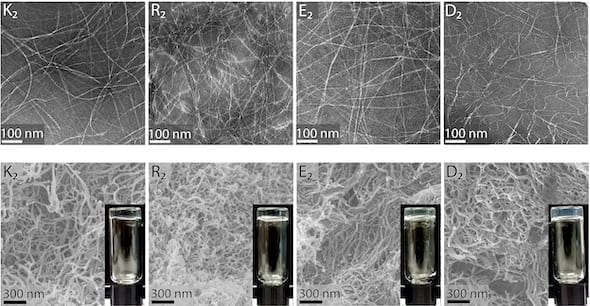
Rice, Texas Heart Institute scientists model how synthetic gels can tune body’s inflammatory response
Hydrogels for healing, synthesized from the molecules up by Rice University bioengineers, are a few steps closer to the clinic.
Rice researchers and collaborators at Texas Heart Institute (THI) have established a baseline set of injectable hydrogels that promise to help heal wounds, deliver drugs and treat cancer. Critically, they’ve analyzed how the chemically distinct hydrogels provoke the body’s inflammatory response — or not.
Hydrogels developed at Rice are designed to be injectable and create a mimic of cellular scaffolds in a desired location. They serve as placeholders while the body naturally feeds new blood vessels and cells into the scaffold, which degrades over time to leave natural tissue in its place. Hydrogels can also carry chemical or biological prompts that determine the scaffold’s structure or affinity to the surrounding tissue.
The study led by chemist and bioengineer Jeffrey Hartgerink and graduate student Tania Lopez-Silva at Rice and Darren Woodside, vice president for research and director of the flow cytometry and imaging core at THI, demonstrates it should be possible to tune multidomain peptide hydrogels to produce appropriate inflammatory response for what they’re treating.
The research appears in Biomaterials.
“We’ve been working on peptide-based hydrogels for a number of years and have produced about 100 different types,” Hartgerink said. “In this paper, we wanted to back up a bit and understand some of the fundamental ways in which they modify biological environments.”
The researchers wanted to know specifically how synthetic hydrogels influence the environment’s inflammatory response. The two-year study offered the first opportunity to test a variety of biocompatible hydrogels for the levels of inflammatory response they trigger.
“Usually, we think of inflammation as bad,” Hartgerink said. “That’s because inflammation is sometimes associated with pain, and nobody likes pain. But the inflammatory response is also extremely important for wound healing and in clearing infection.
“We don’t want zero inflammation; we want appropriate inflammation,” he said. “If we want to heal wounds, inflammation is good because it starts the process of rebuilding vasculature. It recruits all kinds of cells that are regenerative to that site.
The labs tested four basic hydrogel types — two with positive charge and two negative — to see what kind of inflammation they would trigger. They discovered that positively charged hydrogels triggered a much stronger inflammatory response than negatively charged ones.
“Among the positive materials, depending on the chemistry generating that charge, we can either generate a strong or a moderate inflammatory response,” Hartgerink said. “If you’re going for wound-healing, you really want a moderate response, and we saw that in one of the four materials.
“But if you want to go for a cancer treatment, the higher inflammatory response might be more effective,” he said. “For something like drug delivery, where inflammation is not helpful, one of the negatively charged materials might be better.
“Basically, we’re laying the groundwork to understand how to develop materials around the inflammatory responses these materials provoke. That will give us our best chance of success.”
The THI team helped analyze the cellular response to the hydrogels through multidimensional flow cytometry.
“The results of this work lay the groundwork for specifically tailoring delivery of a therapeutic by a delivery vehicle that is functionally relevant and predictable,” Woodside said. “Aside from delivering drugs, these hydrogels are also compatible with a variety of cell types.
“One of the problems with stem cell therapies at present is that adoptively transferred cells don’t necessarily stay in high numbers at the site of injection,” he said. “Mixing these relatively inert, negatively charged hydrogels with stem cells before injection may overcome this limitation.”
Hartgerink said the work is foundational, rather than geared toward a specific application, but is important to the long-term goal of bringing synthetic hydrogels to the clinic. “We have been speculating about a lot of the things we think are good and true about this material, and we now have more of a sound mechanistic understanding of why they are, in fact, true,” Hartgerink said.
Learn more: Hydrogels control inflammation to help healing
Go deeper with Bing News on:
Hydrogels to control inflammation
- Is Ozempic the New Anti-Inflammatory Wonder Drug?
Some GLP-1s are now FDA approved for chronic weight management, including Wegovy (semaglutide) and Saxenda (liraglutide), while others like Ozempic (semaglutide) are approved for type 2 diabetes but ...
- Skin Care News
Apr. 2, 2024 — Polymer-based hydrogels are used to treat skin ailments ... is responsible for causing psoriasis -- a chronic inflammatory skin disease that causes patients to develop red ...
- Control and Intervention
The Control and Intervention Program Area is critical not only to understanding mechanisms by which infection, disease, inflammation can occur, but also to further defend against those mechanisms. The ...
- Entyvio - Uses, Side Effects, and More
This causes inflammation in the gut. Entyvio stops these white blood cells from getting into your gut, helping to control inflammation and prevent damage. How is Entyvio supplied (dosage forms)?
- Ocular marks early-stage trial win for diabetic retinopathy candidate
Ocular Therapeutix (OCUL stock gained on positive Phase 1 results for its retinal disease candidate Axpaxli in diabetic retinopathy. Read more here.
Go deeper with Google Headlines on:
Hydrogels to control inflammation
[google_news title=”” keyword=”hydrogels to control inflammation” num_posts=”5″ blurb_length=”0″ show_thumb=”left”]
Go deeper with Bing News on:
Inflammatory response
- 6 Subtle Ways Your Body Is Telling You That You May Have Gut Inflammation
When your gut is inflamed, you may notice that your skin flares up as well. “The gut microbiome modulates the immune system's response to inflammation, influencing the development and progression of ...
- Study discovers how protein is responsible for genetic inflammatory disease
A team of researchers revealed the significance of a particular protein complex in some types of immunological dysregulation.
- Protein responsible for genetic inflammatory disease identified
A team of researchers led by Dr. Hirotsugu Oda at the University of Cologne's CECAD Cluster of Excellence for Aging Research has discovered the role a specific protein complex plays in certain forms ...
- Experts list anti-inflammation foods that reduce risk of cancer and dementia
Chronic inflammation can lead to a number of serious health conditions, including cancer, heart disease, diabetes, arthritis, depression and Alzheimer's. But eating the right foods can help ...
- Jeremy Renner Is 'Full of Gratitude and Inflammation' While Out for a Jog: 'Be Better, Get Stronger'
Jeremy Renner shared a video of himself appearing to wrap up a jog to his Instagram page while writing a positive message for his followers. "Wishing you a Happy Friday … nothing but smiles today.
Go deeper with Google Headlines on:
Inflammatory response
[google_news title=”” keyword=”inflammatory response” num_posts=”5″ blurb_length=”0″ show_thumb=”left”]










